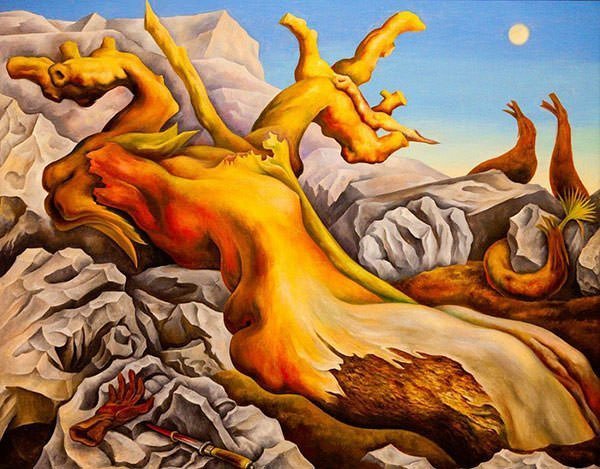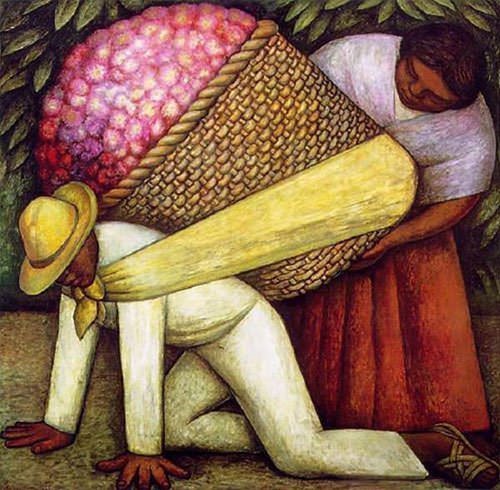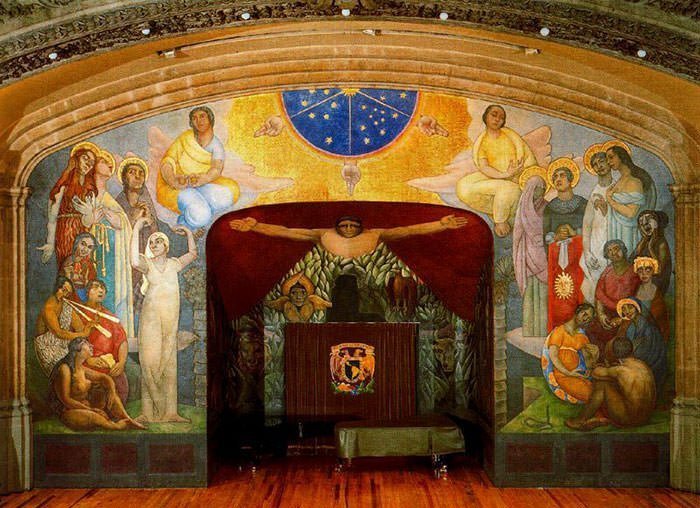Active during the first half of the twentieth century, Diego Rivera (1886 – 1957) was a Mexican painter who is most famous for his large wall paintings or murals. Considered a genius who could turn his hand to any style including Impressionist, Post-Impressionist, Cubist and Flemish, Rivera believed that everyone should be able to view his art and hence painted large murals on public buildings. Know more about the art of Diego Rivera by studying his 10 most famous works including paintings like The Flower Carrier and murals like those he created for the Detroit Industry.
#10 Frozen Assets

| Type: | Mural |
| Location: | Whitney Museum of American Art, New York, U.S. |
| Year: | 1931 |
In 1931, Diego Rivera first produced five portable murals for the Museum of Modern Art in New York City depicting events in Mexican history and then after the exhibition opened he created three more murals, each capturing scenes of Depression-era New York. Frozen Assents is one of those three. The panel’s top half depicts recognizable skyscrapers while the lowest depicts a bank’s waiting room. The mural is considered a shrewd insight into the reality of New York and struck a chord among the public amid the depression.
#9 Symbolic Landscape

| Type: | Oil on Canvas |
| Location: | SFMOMA, San Francisco, California, U.S. |
| Year: | 1940 |
Diego Rivera had a tumultuous relationship with another famous Mexican artist Frida Kahlo. They divorced in 1939 but remarried later and remained together till Kahlo’s death in 1954. This renowned painting was created during the period Rivera was saddened due to his divorce from Kahlo. The painting depicts a fallen tree with a smooth bark surrounded by stones which take all kinds of shapes, and other symbolic objects. It uses a colorful natural landscape to symbolically portray the circumstances he was facing at the time.
#8 Dream of a Sunday Afternoon in Alameda Park

| Type: | Mural |
| Location: | Museo Mural Diego Rivera, Mexico City, Mexico |
| Year: | 1947 |
This mural is the most famous artwork of Museo Mural Diego Rivera. Originally created for the Versailles restaurant at the hotel Prado, it was moved to the museum after the hotel was destroyed in the 1985 Mexico City earthquake. Alameda Central is a public municipal park in downtown Mexico City which has witnessed several important events in Mexican history. The mural depicts these events along with famous Mexican people passing through the park. At the center of the artwork is representation of La Calavera Catrina, a famous female skeleton etching by Mexican illustrator José Guadalupe Posada.
#7 Fertile Land

| Type: | Mural |
| Location: | National School of Agriculture, Chapingo, Mexico |
| Year: | 1926 |
Chapingo Autonomous University is an agricultural college located in Texcoco, Mexico. It initially began as National School of Agriculture. It houses one of the most famous murals by Diego Rivera. Popularly known as “Tierra Fecundada” (Fertile Land), the work is divided into three parts. The left panel depicts man’s struggle to have land, the right panel shows the evolution of Mother Nature and the center shows the communion between man and earth. Fertile Field is considered among Rivera’s best works.
#6 The Flower Carrier

| Type: | Oil on Masonite |
| Location: | National School of Agriculture, Chapingo, Mexico |
| Year: | 1935 |
This painting is one of the most famous depictions of the struggle of a common worker living in a capitalist society. Rivera uses vibrant colors to depict a common man on all fours, finding it difficult to carry the load of an oversized basket of flowers. A woman, most likely the peasant’s wife, stands behind him and is trying to help him lift the load. While the viewer can view the beauty of the flowers, the peasant is oblivious to it due to his position.
#5 Creation

| Type: | Mural |
| Location: | San Ildefonso College, Mexico City, Mexico |
| Year: | 1922 |
This was the first government-commissioned mural of Rivera and is considered one of his earliest masterpieces. It was created over the course of a year and covers over a thousand square feet. The artwork depicts a number of allegorical figures including Faith, Hope, Charity, Education and Science. Considered a benchmark for Mexican Muralism, the Creation can be seen at San Ildefonso College, a museum and cultural center in Mexico City regarded as the birthplace of the Mexican muralism movement.
#4 Agrarian Leader Zapata

| Type: | Mural |
| Location: | Museum of Modern Art, New York City, U.S. |
| Year: | 1931 |
Emiliano Zapata was the foremost leader of the peasant revolution in the Mexican state of Morelos and among the leading figures in the Mexican Revolution. He was also the inspiration of the agrarian movement known as Zapatismo. This fresco, which shows Zapata with the bridle of a majestic white horse in his hand and standing above the dead body of a land owner, was produced as part of eight portable frescoes for Rivera’s solo exhibition at the Museum of Modern Art (MoMA) in 1931. Agrarian Leader Zapata is among the most renowned depictions of the Mexican leader and is considered a landmark in Mexican art.
#3 The History of Mexico

| Type: | Mural |
| Location: | National Palace, Mexico City, Mexico |
| Year: | 1929 – 1935 |
In August 1929, Rivera began painting his grand murals in the large stairways and stairwells of the National Palace, the center of the Mexican government located on Mexico City’s main square. The North Wall section of the mural depicts the richness of the ancient Aztec culture. The main West Wall is the central part of the mural and summarizes the history of Mexico as a series of conflicts, rebellions and revolution against oppression. The South Wall contains images of a better future of Mexico with progress and prosperity. Among Rivera’s most famous works, the murals have been jointly titled “The Epic of the Mexican People”.
#2 Detroit Industry Murals

| Type: | Mural |
| Location: | Detroit Institute of Arts, Detroit, U.S. |
| Year: | 1932 – 1933 |
In 1932, Diego Rivera was commissioned to paint twenty-seven frescoes in the Detroit Institute of Art in Midtown Detroit, Michigan, U.S. From the 27 murals that Rivera painted, the two largest murals are located on the north and south walls. They depict laborers working at Ford Motor Company’s River Rouge Plant. Other panels depict advances made in various scientific fields, such as medicine and technology. Rivera considered the Detroit Industry Murals to be his most successful work. In 2014, the murals were given National Historic Landmark Status.
#1 Man at the Crossroads

| Type: | Mural |
| Location: | Palacio de Bellas Artes, Mexico City, Mexico |
| Year: | 1934 |
This fresco was first commissioned by the Rockefellers for ground-floor wall of Rockefeller Center in New York City. However it couldn’t be completed as Rivera refused to remove a portrait of Lenin which was causing a controversy. It was subsequently destroyed but Rivera had black-and-white photographs of it. Using these, he recreated a nearly identical mural at the Palacio de Bellas Artes in Mexico City. It was renamed Man, Controller of the Universe. At the center of this masterpiece is a workman controlling machinery with a fist holding an orb in front of him. 4 propeller-like shapes stretch from center to corner of the composition representing discoveries made possible by science. The composition also depicts a contrast between Capitalism and Socialism with wealthy people playing cards and smoking in the left while on the right Lenin is seen holding hands with a multi-racial group of workers. It is definitely the most renowned masterpiece by Diego Rivera.

